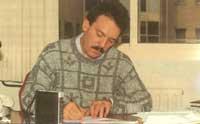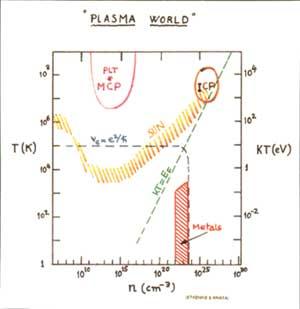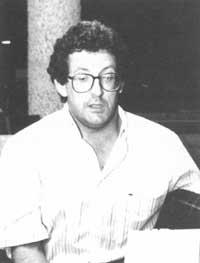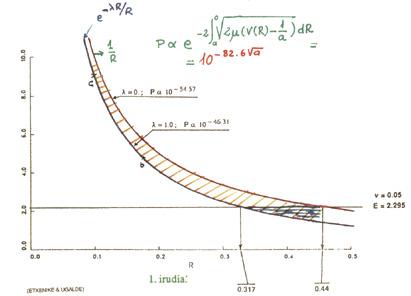Cold fusion: is it cooling?
No new mergers under the sun
Bertil Wilner (Nature, 18/5/1989, p. 180)
Electrochemical fusion is a well-known topic of discussion. It is not a new topic. In Nature, the 27th of April, the claim of Fritz Paneth and Kurt Peters was announced in the 1920s. According to them, the common hydrogen, absorbed in the palladium, formed helium 1. In the same issue, Steven Dickman refers to Tandberg's work at the Electrolux laboratories in Stockholm. This work resembles the current one due to the presence of electrochemical cells and heat waste. My father, Torsten Wilner, worked with Tandberg on this nuclear research and others. I still have their observations and there are many different and fascinating perspectives.

Tandberg entered this work in a transversal way. In 1925 he began looking for the right metals to confine hydrogen in refrigerators. He was interested in palladium, but sought opposite characteristics (permeability and hydrogen absorption capacity). The work of Paneth and Peters (who wanted to create helium to fill the esceppelins, with the “spontaneous nuclear catalisis” of the hydrogen atoms produced by palladium, also expected the generation of heat, which did not interest them) had a great influence on him. Dickman's note says that helium was spectroscopic. Helium was atmospheric and not produced by nuclear reactions.
This work, Tandberg, was followed to concentrate hydrogen on the surface of the palladium by electrolysis (aiming to reach a high hydrogen pressure, as indicated by him). The main consequence was energy generation. The original title of the patent application, made by Tandberg in 1927, was “Atomic Energy Extraction Method”, although it was later given the following name: “A method to obtain helium.” It was a concession to the patent office.
The patent was not accepted. The main reason given was: Tandberg was unable to answer the office's biggest objection: “What is the most concentrated hydrogen?” The energy extraction mechanism needed a better explanation and the explanation given was not complete enough for a person to use the invention. After the discovery of deuterium in 1932, Tandberg and Wilner repeated the experiment with heavy water, probably provided by Niels Bohr.
The merger burned and both began to experiment. Explosion threads were used, which are currently used in some laboratories to accelerate ions and take the energy needed to overcome Coulomb repulsion. The high-voltage capacitors were electrochemically discharged through small palladium rods loaded with deuterium. On the first day of discharge, Tandeberg asked my father to abandon him to inform him of what happened in case of nuclear explosion. Nothing spectacular happened, although the noise generated by the discharges became common in the laboratory. No clear and decisive results were obtained, perhaps due to the lack of adequate analytical techniques. Observations describing the experiments, if I still have palladium rods and heavy water.
Tandberg and Wilner followed the experiments in the basement of my father's house. The famous experiment of Cockroft and Walton (artificial transformation of two alpha particles by accelerated protons of the 7 Li isotope) was repeated. In some later experiments, when bombarding a sheet of palladium saturated with deuterium with accelerated deuterium, the nuclear reaction (d + d = 3 He + n) was observed that has aroused interest. Created neutrons are cushioned with paraffin wax and detected by silver activation.

Opinion of Toribio Fernández
For over a hundred years the high hydrogen absorption capacity of metals 2 has been known. In the bibliography there are many examples of this. For example, when it comes to avoiding corrosion processes, when iron is cathodic polarized, excessive polarization produces hydrogen. Hydrogen is absorbed by iron, hydrogen bubbles form inside the metal, tension increases and metal becomes fragile. Deterioration of the entire metal mesh.
The original idea was mentioned long ago in the bibliography. Since metals can absorb a lot of hydrogen, deuterium was thought to bleach. Deuterium has a neutron and being immersed and packaged in the palladium, the nuclei of the deuterium atoms exceed the repulsion force of Coulomb and increases the possibility of interacting, that is, a fusion may occur.
On the other hand, when the electrolysis of water is carried out in special conditions, the generation of excess energy is known for a long time. The quantity is low and requires high precision measurements for detection. In order for the amounts of heat to be measurable, it takes at least twenty-four hours and those who have little calorimetric experience know how difficult it is to maintain a closed system without heat exchange for 24 hours. This is the first problem.

The second problem is that if the excess heat is due to nuclear fusion, neutrons and gamma rays must be generated. Because the energy that is going on and the heat that is generated are small, the number of neutrons and radiation are also small. To carry out this work it is necessary to have experts of high level in calorimetric and radiation measures to obtain good results. The cruelest criticism of Fleischmann has been carried out through the cosmic radiation it is measuring and the poor calorimetric measurement.
American physicists have been very demanding. There may be envy. In fact, in recent years hundreds of billions of dollars have been spent to achieve nuclear fusion and they don’t like a “soap dish” in the oria, as they say, to spend as little as 20,000 dollars.
On the other hand, Fleischmann is a prime character among electrochemists. He is the creator of the largest and most solid group working in electrochemistry. Most of the electrochemicals currently working in the world have gone through their equipment. He has always worked on the latest research, developed new working methodologies and solved many questions raised since ancient times. Pons, for his part, has been a student of Fleischmann and enjoys great prestige despite his curious history. He started working in North America. He wanted to go back to college, but they didn't accept it because he let his opportunity pass. He arrived in England with Fleischmann.
The truth is that I am skeptical. The system is there. Since the 1920s it has been analyzed four or five times. Something happens that people don't know how to explain. Let the waters warm. Eight or ten world groups must be left to seriously discuss the problem. Then the futures. I am willing to work on that same self, if after the theoretical exams it is seen that the work will be fruitful and useful.
I think if things continue as they are, cold fusion will not solve the world's energy problems. The amount of energy generated is very small and the time is very long. If we add two calories theoretically and get 20, it's huge. However, if we need four days to introduce these two calories and four days to take out the twenty, the energy production system cannot work that way. At the moment, the practical use should be ‘soaked’.
Perspective of physicists: Pedro Maria Etxenike
I think the whole problem is something strange. The usual channels of dissemination of scientific knowledge have not been followed. They are much more prudent. For example, in the case of high temperature superconductivity, the data remained first closed, the referee studied 3 and finally published. In this case, although experimental results are published in the Journal of Electrochemistry, published by the Scandinavian academy, they have been carried out mainly in propaganda newspapers.
I find it difficult for me to have a nuclear reaction, such as d + d = 3 He + n. The number of neutrons generated in this type of nuclear reactions is deadly for experimenters. In this case, for their sake, the experimental ones are alive.
Between both claims, those of Jones 4 and those of others are very different. Jones' results are a billion times lower.
Theoretically it is very difficult for palladium to play hard enough to produce fusion. The problem of fusion is the coulombian repulsion of two electric charges of the same sign. Two loads of the same sign cannot be added because the possibility of overcoming the coulombian barrier is very small. Palladium can change this repulsion potential, but very little. That is what Jesus Ugalde and I are studying here.
Palladium may vary the probability in a different way. Modifying the effective mass of electrons. This modifies the probability that one electron approaches another. This was known some time ago, since in the case of muons it occurs more dramatically. If the hydrogen molecule formed in muons instead of electron, with an atomic radius 207 times lower, the probability would increase enormously. This is called muon fusion. The idea is very old, Luis Alvarez and Sajarov have mentioned this kind of ideas.
In this case, although the effective mass of the electron varies greatly with the ion network and interaction with other electrons makes it difficult to think of electrons that are 207 times heavier.
Another way to reduce interaction is to reduce coulombian repulsion. As we calculated Ugalde and I, the probability of one proton finding another is ten to minus 54 (red curve of Figure 1). If the shielding changes a lot, that is, if you consider that other electrons make their repulsion less, the probability is ten to minus 46 (blue curve). The change is huge, one hundred million, but as we have started very low...

It is the usual way to explain fusion. The probability of overcoming the energy barrier is the integral of Figure 1. It is graphically defined as the surface between the curve of Figure 1 and the horizontal straight line. Going from the red curve to the blue is evident the great change. When moving from point b to point c in the curve (the energy of point c is greater than that of point b), the surface decreases considerably and the probability increases. That is why a hard method is always chosen in fusion, that is, high temperatures and a lot of energy.
Figure 2 shows what happens in the Sun. In the ordered ones, the temperature on the left and on the right the energy is represented. Density in abscisas. The curve corresponding to the sun is the one that is in yellow and represents the conditions in which the fusion occurs. It requires high temperatures and energies. Cold fusion is represented by the red part, which represents low temperatures and energies. The probability is very low. When so far they have tried to make nuclear fusion, they have worked in the brown and purple zone of the image. Purple corresponds to the method called ‘magnetically confined plasma’ (MCP) and brown to the so-called ‘ionized confined plasma’ (PCI).
In cold nuclear fusion there are no accounts. There is something very interesting, but it is not a cold fusion. All the stir is because the unconfirmed data has been put very soon before the public. In addition, Fleischmann's article is dark and surprising, because it is a first-rate scientist. Jones' article, for example, has been published in Nature because it has answered the questions raised by the referee. This has not happened in the case of Fleischmann. On the other hand, the energies that Jones claims are within the cold fusion and, even if they are at one end, are within the theory.
- Paneth and Peters were two German physicists who announced in 1926 the creation of helium from hydrogen as a catalyst for palladium. Eight months later, they rejected what was said when they realized that there were several experimental errors.
- Keep in mind that cold fusion occurs in saturated palladium.
- Referees are experts who judge the quality of articles that are sent to scientific journals.
- Jones, an American physicist, has conducted an experiment similar to that conducted by Fleischmann and Pons, but his results (heat generation and neutron flow) are not as bright as those of these.
Buletina
Bidali zure helbide elektronikoa eta jaso asteroko buletina zure sarrera-ontzian











